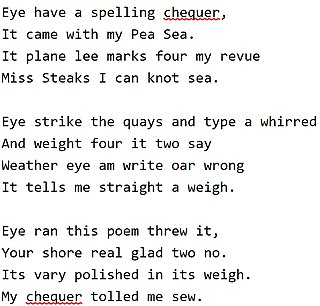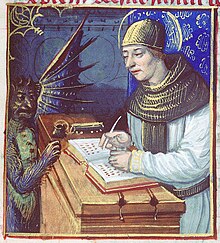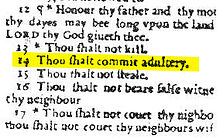
The Codex Sinaiticus, designated by siglum א [Aleph] or 01, δ 2, also called Sinai Bible, is a fourth-century Christian manuscript of a Greek Bible, containing the majority of the Greek Old Testament, including the deuterocanonical books, and the Greek New Testament, with both the Epistle of Barnabas and the Shepherd of Hermas included. It is written in uncial letters on parchment. It is one of the four great uncial codices. Along with Codex Alexandrinus and Codex Vaticanus, it is one of the earliest and most complete manuscripts of the Bible, and contains the oldest complete copy of the New Testament. It is a historical treasure, and using the study of comparative writing styles (palaeography), it has been dated to the mid-fourth century.

Typography is the art and technique of arranging type to make written language legible, readable and appealing when displayed. The arrangement of type involves selecting typefaces, point sizes, line lengths, line spacing, letter spacing, and spaces between pairs of letters. The term typography is also applied to the style, arrangement, and appearance of the letters, numbers, and symbols created by the process. Type design is a closely related craft, sometimes considered part of typography; most typographers do not design typefaces, and some type designers do not consider themselves typographers. Typography also may be used as an ornamental and decorative device, unrelated to the communication of information.

The Masoretic Text is the authoritative Hebrew and Aramaic text of the 24 books of the Hebrew Bible (Tanakh) in Rabbinic Judaism. The Masoretic Text defines the Jewish canon and its precise letter-text, with its vocalization and accentuation known as the mas'sora. Referring to the Masoretic Text, masorah specifically means the diacritic markings of the text of the Jewish scriptures and the concise marginal notes in manuscripts of the Tanakh which note textual details, usually about the precise spelling of words. It was primarily copied, edited, and distributed by a group of Jews known as the Masoretes between the 7th and 10th centuries of the Common Era (CE). The oldest known complete copy, the Leningrad Codex, dates from the early 11th century CE.

Textual criticism is a branch of textual scholarship, philology, and literary criticism that is concerned with the identification of textual variants, or different versions, of either manuscripts (mss) or of printed books. Such texts may range in dates from the earliest writing in cuneiform, impressed on clay, for example, to multiple unpublished versions of a 21st-century author's work. Historically, scribes who were paid to copy documents may have been literate, but many were simply copyists, mimicking the shapes of letters without necessarily understanding what they meant. This means that unintentional alterations were common when copying manuscripts by hand. Intentional alterations may have been made as well, for example, the censoring of printed work for political, religious or cultural reasons.
Spelling is a set of conventions for written language regarding how graphemes should correspond to the sounds of spoken language. Spelling is one of the elements of orthography, and highly standardized spelling is a prescriptive element.
Proofreading is an iterative process of comparing galley proofs against the original manuscripts or graphic artworks to identify transcription errors in the typesetting process. In the past, proofreaders would place corrections or proofreading marks along the margins. In modern publishing, material is generally provided in electronic form, traditional typesetting is no longer used and thus this kind of transcription no longer occurs.

A scrivener was a person who, before the advent of compulsory education, could read and write or who wrote letters as well as court and legal documents. Scriveners were people who made their living by writing or copying written material. This usually indicated secretarial and administrative duties such as dictation and keeping business, judicial, and historical records for kings, nobles, temples, and cities. Scriveners later developed into notaries, court reporters, and in England and Wales, scrivener notaries.

In software, a spell checker is a software feature that checks for misspellings in a text. Spell-checking features are often embedded in software or services, such as a word processor, email client, electronic dictionary, or search engine.

Typing is the process of writing or inputting text by pressing keys on a typewriter, computer keyboard, mobile phone, or calculator. It can be distinguished from other means of text input, such as handwriting and speech recognition. Text can be in the form of letters, numbers and other symbols. The world's first typist was Lillian Sholes from Wisconsin in the United States, the daughter of Christopher Sholes, who invented the first practical typewriter.

Throughout history, printers' errors, unconventional translations and translation mistakes have appeared in a number of published Bibles. Bibles with features considered to be erroneous are known as Bible errata, and were often destroyed or suppressed due to their contents being considered heretical by some.

.cm is the country code top-level domain (ccTLD) for Cameroon.
Predictive text is an input technology used where one key or button represents many letters, such as on the physical numeric keypads of mobile phones and in accessibility technologies. Each key press results in a prediction rather than repeatedly sequencing through the same group of "letters" it represents, in the same, invariable order. Predictive text could allow for an entire word to be input by single keypress. Predictive text makes efficient use of fewer device keys to input writing into a text message, an e-mail, an address book, a calendar, and the like.
Spelling suggestion is a feature of many computer software applications used to suggest plausible replacements for words that are likely to have been misspelled.
A correction in a newspaper consists of posting a public notice about a typographical error or factual mistake in a previously published article.
A transcription error is a specific type of data entry error that is commonly made by human operators or by optical character recognition (OCR) programs. Human transcription errors are commonly the result of typographical mistakes; putting one's fingers in the wrong place while touch typing is the easiest way to make this error. Electronic transcription errors occur when the scan of some printed matter is compromised or in an unusual font – for example, if the paper is crumpled, or the ink is smudged, the OCR may make transcription errors when reading.
A manuscript culture is a culture that depends on hand-written manuscripts to store and disseminate information. It is a stage that most developed cultures went through in between oral culture and print culture. Europe entered the stage in classical antiquity. In early medieval manuscript culture, monks copied manuscripts by hand. They copied not just religious works, but a variety of texts including some on astronomy, herbals, and bestiaries. Medieval manuscript culture deals with the transition of the manuscript from the monasteries to the market in the cities, and the rise of universities. Manuscript culture in the cities created jobs built around the making and trade of manuscripts, and typically was regulated by universities. Late manuscript culture was characterized by a desire for uniformity, well-ordered and convenient access to the text contained in the manuscript, and ease of reading aloud. This culture grew out of the Fourth Lateran Council (1215) and the rise of the Devotio Moderna. It included a change in materials, and was subject to remediation by the printed book, while also influencing it.
A biblical manuscript is any handwritten copy of a portion of the text of the Bible. Biblical manuscripts vary in size from tiny scrolls containing individual verses of the Jewish scriptures to huge polyglot codices containing both the Hebrew Bible (Tanakh) and the New Testament, as well as extracanonical works.
Muphry's law is an adage that states: "If you write anything criticizing editing or proofreading, there will be a fault of some kind in what you have written." The name is a deliberate misspelling of "Murphy's law".
Typosquatting, also called URL hijacking, a sting site, a cousin domain, or a fake URL, is a form of cybersquatting, and possibly brandjacking which relies on mistakes such as typos made by Internet users when inputting a website address into a web browser. A user accidentally entering an incorrect website address may be led to any URL, including an alternative website owned by a cybersquatter.
A fat-finger error is a keyboard input error or mouse misclick that occurs from a simple input mistake, causing unwanted secondary behavior. In common parlance, it simply refers to a common typographical error made on a touchscreen or physical keyboard that occurs when the wrong selection is made, or multiple selections are made due to options or keyboard keys being too close together.












